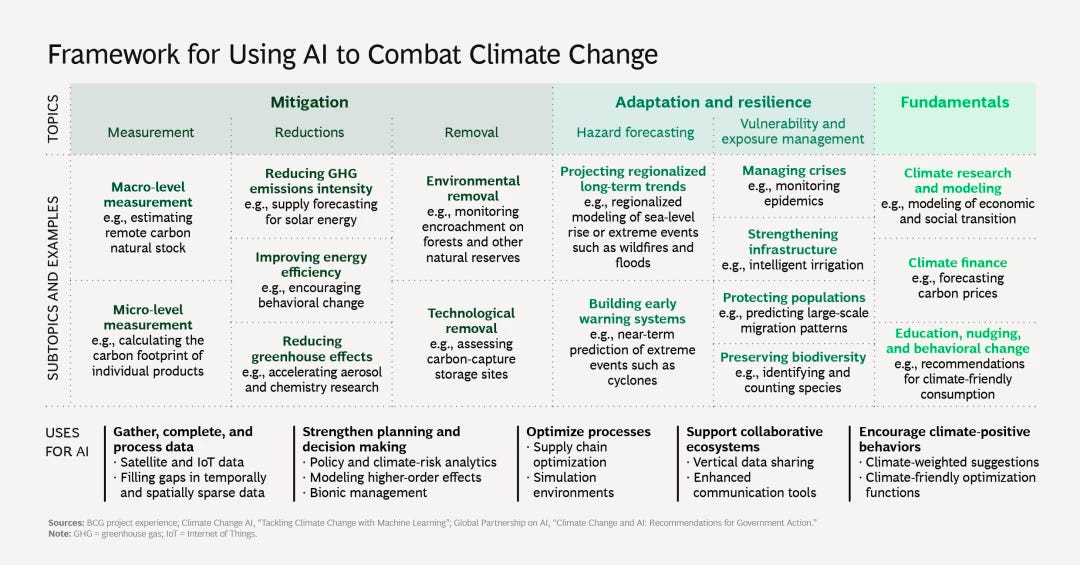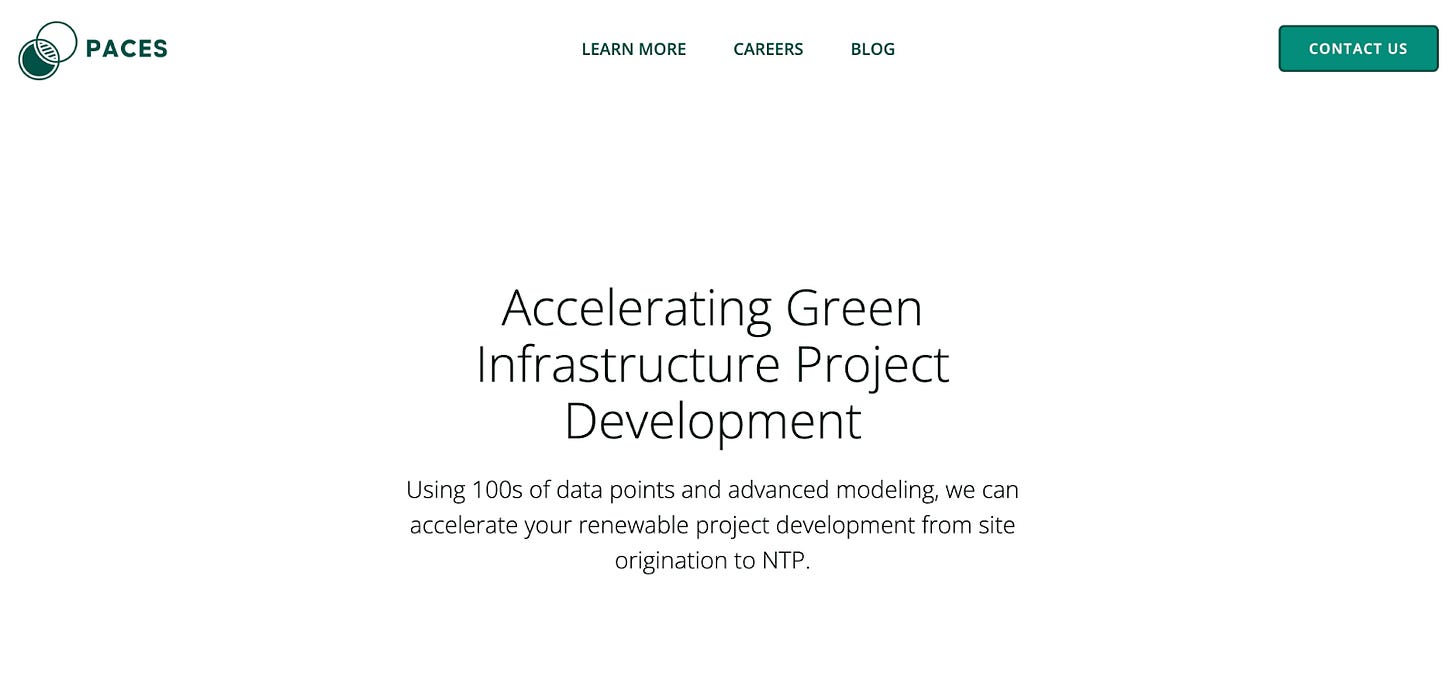AI to Combat Climate Change
There are countless opportunities for artificial intelligence to optimize the way we live, work, allocate resources, and more to fight climate change and adapt to its effects.
New applications of AI are helping startups and corporations fight climate change through optimizations and better decision-making. AI has the ability to analyze huge datasets and find patterns humans can't, which creates countless opportunities to optimize the way we live, work, allocate resources, and more.
How AI-Built Applications Can Help Combat Climate Change
AI can help tackle a wide range of challenges, from predicting and mitigating the impacts of extreme weather events to optimizing energy usage and reducing waste. With AI, climate tech startups can gather and analyze complex datasets on carbon emissions, energy prices, consumer behavior, and more. This can be used to make informed decisions to combat carbon emissions and build a greener society.
Keeping this in mind, Boston Consulting Group (BCG) recently surveyed public and private companies that are fighting climate change with AI and came up with some encouraging insights:
87% of climate and AI leaders find AI to be helpful in fighting climate change
43% of climate tech leaders want to integrate AI into their current technology
More than half of the US leaders have the vision of using AI to fight climate change
78% of the leaders cite there’s insufficient access to AI in the organization
67% of private sector leaders feel that the government should do more to support and enhance AI technology
Public and private sector leaders think reducing carbon emissions is where AI-enabled climate technology will be of the most use
Based on this survey, BCG created a framework that explains how AI can be a part of climate tech in diverse ways:
The framework has three major parts - Mitigation, Adaptation and resilience, and Fundamentals.
1. Mitigation
Mitigation encompasses the actions taken to reduce or prevent greenhouse gas emissions and limit the negative effects of climate change. These actions can include:
Implementing clean energy technologies
Increasing energy efficiency
Adopting low-carbon transportation options
Promoting sustainable land use practices
2. Adaptation and Resilience
Adaptation is the process of adjusting to the expected future climate to reduce vulnerability and increase resilience. It involves identifying specific impacts of climate change in different sectors and taking actions to minimize risks and enhance opportunities.
Resilience refers to the ability of a system to bounce back from a disturbance, such as a large-scale weather event. Resilience strategies focus on building the capacity of individuals, communities, and systems to anticipate and prepare for changing conditions.
3. Fundamentals
Artificial intelligence (AI) has the potential to support various aspects of climate change mitigation and adaptation.
For example, AI can be used to enhance:
Climate research and modeling: Modeling of economic and social transition
Facilitate climate finance: Forecasting carbon prices
Educating, nudging, and behavioral changes: Recommendations for climate-friendly consumption
AI Has Opened Doors to Multiple Opportunities in Climate Tech
One of the biggest advantages of AI is its ability to analyze large sets of data and come up with solutions. Data analysis is a key aspect for many companies working in climate tech. Here’s how AI can help:
Monitoring and predicting climate patterns and impacts: Analyze a large amount of data, identify patterns, and make more accurate predictions about future climate impacts.
Energy management and optimization: AI can analyze real-time data on energy consumption and production for a company and suggest a course of action to optimize energy management.
Sustainable agriculture and forestry: Improve the efficiency and sustainability of agriculture by analyzing soil and weather data, optimizing irrigation and fertilizer use, and predicting crop yields.
Transportation and urban planning: Optimize traffic flow in urban areas, which can reduce congestion and energy consumption (Google Maps already does this to some extent). AI can also analyze traffic data, provide personalized routing recommendations, and reduce fuel consumption and emissions.
Disaster response and risk management: Study weather patterns and provide advanced warnings that can alert people in the area about the potential threat.
During my research, I came across some startups that are embedding AI with their current climate tech product.
Startups Have Already Come Up with Innovative AI tech to Fight Climate Change
1. Paces - Accelerating Green Infrastructure Project Development
Paces gathers data to help green infrastructure developers decide where to develop their projects, giving them a higher chance of success from the beginning. “80% of the 1,269 clean energy projects developers start never actually get built because most projects are started without deep due diligence on zoning and interconnection due to the cost of collecting that data. This means $51B worth of canceled projects over the next 3 years.” - James McWalter, CEO.
AI will allow Paces to provide the best recommendations to their customers, effectively increasing the amount of renewable energy production on the grid. It’s important to increase the amount of renewable energy on the grid to lower fossil fuel usage for generating electricity and protecting our environment from climate change. The global renewable energy market was valued at $881.7 billion in 2020 and is projected to reach $1.9 trillion by 2030, growing at a CAGR of 8.4% from 2021 to 2030.
2. Sipremo - Natural Disaster and Climate Change Forecasting
Sipremo is analyzes data and forecasts the possibility of natural disasters or climate change in an area. They have a four-step process that helps predict changes.
Step 1: Artificial Intelligence: Enables businesses to predict and mitigate the impact of climate events through proactive and assertive decision-making.
Step 2: Contextualization: The framework considers climate change variables to generate operational insights that enhance resilience, reduce damage and loss, and mitigate the impact of climate events on businesses.
Step 3: Innovation and Adoption: Come up with a climate adaptation strategy based on the risks and impacts it might have.
Step 4: Resilience and Proactivity: Contribute to cost and bureaucracy reduction, response time reduction, and operational activity optimization.
3. Avalo - Accelerated Adaptation of Crops to Climate Change
According to USAID, food production needs to increase by at least 60% by 2050 to feed our growing global population. Avalo is en route to making it happen. Its AI-based platform streamlines the costly and time-consuming aspects of crop development while identifying the biological origin of traits essential to the future of agriculture.
They help crops adapt to climate change in four ways:
Discover biological traits that make plants resilient to climate change
Create new plant strains that are better tasting and healthier
Help increase diversity by creating plants tailored to different environmental conditions worldwide
Offer bioinformatics services for crop analysis
4. Pano - Actionable Intelligence for Wildfire Management
During wildfires, a significant amount of carbon dioxide is released into the atmosphere as trees and other vegetation burn. This leads to an increase in carbon emissions and raises the temperature of the Earth’s surface. Pano uses AI to predict and communicate wildfire threats to fire professionals, companies, and even homeowners who live near forests.
5. BrainBox AI - Making Buildings Smarter, Greener, and More Efficient
BrainBox has built an AI-powered HVAC (heating, ventilation, and air conditioning) brain that makes buildings energy efficient. According to BrainBox, HVAC systems are responsible for almost 50% of buildings' energy consumption, of which 35% is usually wasted. So, to reduce energy waste, they have come up with a product that connects with the building's HVAC system in three hours and starts analyzing data. It takes two to four months for Brainbox's AI platform to learn a building's thermal behavior.
Once it has analyzed the building's HVAC system, it then feeds external information, such as weather forecasts and energy prices, to the AI and does future forecasting for each zone in a building. By utilizing predictions, the AI technology identifies optimization strategies and independently sends commands to each price of HVAC equipment, ensuring the most comfortable temperatures for occupants while minimizing energy consumption.
How Large Corporations are Using AI for The Climate
Microsoft’s Efforts to Leverage AI to Fight Climate Change
Microsoft is using AI to fight climate change by expanding its AI for Earth program, which aims to "monitor, model, and manage the Earth's natural systems." This program uses AI to collect and analyze data about energy consumption and weather patterns to help conserve power, reduce needless water usage in agriculture, and better manage natural resources.
The expansion of the program will take place in three steps:
Awarding researchers with seed grants for designing and testing new AI applications.
Identifying the most promising applications and scaling them up with larger investments.
Incorporating the most useful applications into services provided to climate scientists and those involved with sustainable initiatives.
The ultimate goal of Microsoft's AI for Earth program is to democratize AI and make it accessible to both scientists and business owners so that they can utilize the technology to analyze climate data and provide information to help take strategic action toward fighting climate change.
Energy Usage Concerns: The Downside of AI
AI has surely opened numerous doors to help fight climate change, but the only downside it seems to have is energy consumption. According to a paper published by the University of Massachusetts, training a single AI model can emit as much carbon as five cars would emit in their lifetimes. And this is just for training a single model. When you use this AI model repeatedly, the net energy consumption increases dramatically.
Why Does AI Consume So Much Energy?
AI requires millions to billions of training examples so that it can learn how to work.
For example, if you want an AI to learn how a dog looks, you will have to provide pictures of every dog species in the world (there are 360 dog species worldwide). You need to train it on many different images of dogs from all angles too. All this, just to identify a dog. Another reason why AI consumes enormous amounts of energy is that it requires many training cycles.
With the continued rate of improvement in computer processing efficiency, this problem is mitigated. But even with that, the increase in AI models being developed and utilized will increase the carbon footprint of AI. For founders, ensuring your cloud services provider sources clean energy and the willingness to pay the green premium for it will further mitigate the negative effects of AI on the environment.
Integrate Your Climate Technology with AI to Reverse Climate Change
When applied creatively, AI can do wonders to help us mitigate the impacts of climate change. Seeing the solutions climate tech entrepreneurs are coming up with to fight climate change makes me optimistic about the future of AI for the climate. Right now, most AI applications within climate tech are making an impact in data analytics and predictions, but I’m excited to see how innovative climate technologists can utilize AI beyond what’s currently in view.
If you enjoyed this article, feel free to share it and subscribe to Warming Up to Climate Tech. This publication is brought to you by Inbound Growth Co - content for climate-focused brands.










